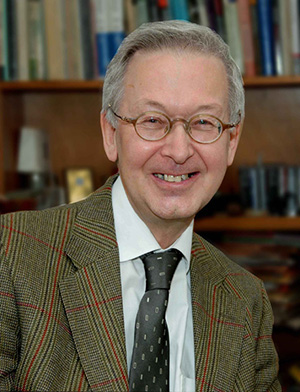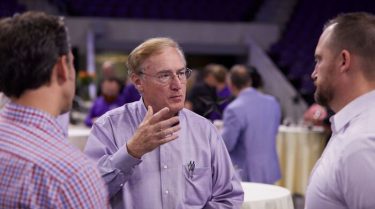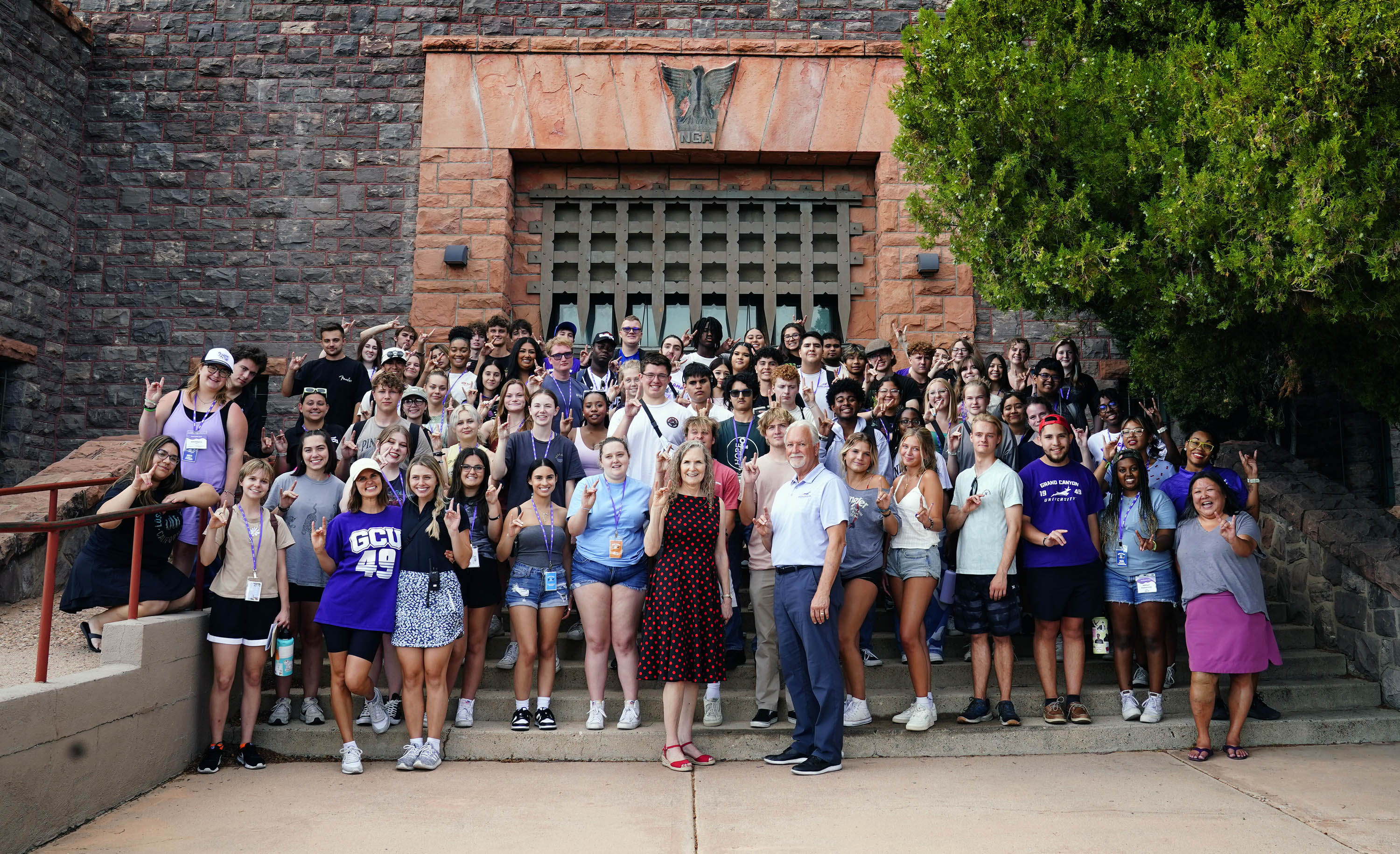
By Lana Sweeten-Shults
GCU News Bureau
Where do science and faith intersect?
For Sir Colin Humphreys, Professor of Materials Science at Queen Mary University in London, science and faith intersected on the astronomy floor of Arizona State University.

It was a story the noted physicist shared on Saturday, the final day of the two-day virtual Conference on Faith and Science hosted by ASU. The event was supported by a grant from the John Templeton Foundation to ASU’s Arizona Center for Christian Studies, and it also received support from various other organizations, including Grand Canyon University.
Humphreys had been pondering a question his then 8-year-old daughter asked him when they were reading a book called “Great Men of History.”
Each page gave the dates of birth and death for each famous man – Julius Caesar, Christopher Columbus, Alexander the Great -- but on the page featuring Jesus, the book said, Jesus Christ: Born 4 B.C. (?); died A.D. 30 (?).
“My daughter said to me, ‘Daddy, why don’t we know the dates when Jesus was born and died?'”
Humphreys wondered the same thing, and in the years after that time with his daughter, he would use science to try to answer those questions.
One of the things he pondered were references in early literature that conveyed how the moon appeared as blood on the night of the Crucifixion. Could there have been an event in nature, he thought, that could explain a blood-red moon?
He would find inspiration for his academic quest on a visit to a colleague at ASU. That morning, he had read Acts, Chapter 2, which says: “The sun shall be turned into darkness, and the moon into blood, before the great and notable day of the Lord.”

He wandered around the physics department, something he had never done before, while waiting to talk to his colleague and, by chance, jaunted upstairs to the astronomy floor.
That’s where he saw a picture in the corridor of astronomical events, including a blood red moon. Underneath that photo, it said “lunar eclipse.”
“I thought, gosh, can this be referring to a lunar eclipse that happens on the evening of the Crucifixion?”
He asked astrophysicist Graeme Waddington if there was a lunar eclipse between A.D. 26 to 36, and there was one visible from Jerusalem: The date was Friday, April 3, A.D. 33.
While Humphreys had leaned on science to determine a clearer date for Jesus’ death, he knew that faith also led him in the right direction.
“I also do think that God does interact with us to produce inspiration, as it were," Humphreys said. Exploring the astronomy department floor that day, “ … I think that’s God being inspiration, really, and guiding us in small things of life, as well as the big things of life.”
The intersection of faith and science.
Integrating faith and science
This was the third year for the Conference on Faith and Science, which GCU hosted on the University’s campus in 2020.

About 50 guest speakers participated in this weekend’s virtual event, and approximately 800 attended, said Dr. Mike Mobley, Professor and Executive Director of GCU’s Office of Research and Innovation.
Mobley was the moderator of the Materials and Molecular Science session, which featured Humphreys and Dr. Andrew Briggs, Professor of Nanomaterials in the Department of Materials at the University of Oxford, whose research has focused on materials with the potential for building quantum computers.
It’s important, Mobley said, for GCU as a Christian university to be a part of academically engaging events such as the Conference on Faith and Science.
“I believe we must encourage Christian students in the sciences. We must integrate faith into every profession – and the sciences are very important. Without faith, the sciences can lead you into pragmatism, materialism and nihilism," he said. "Science may answer the ‘how’ questions for us, but faith answers the ‘why' questions."
He added, “We want students to hear from world-renowned scientists who have demonstrated you can be an excellent scientist and a committed Christian.”
And students did hear from world-renowned scientists, such as Humphreys, who is known for his pioneering work in light-emitting diode, or LED, technology.
At the Materials and Molecular Science session, he spoke about another light -- the one produced by the Star of Bethlehem.
The star, he believes, actually was a bright longtail comet recorded in the Chinese chronicles Ch’ien-han-shu. According to those chronicles, the comet was visible for more than 70 days and appeared in the spring of 5 B.C.
It would be during the spring, specifically during Passover, that people flocked to Jerusalem, which could explain why there was no room at the inn in Bethlehem, a neighboring village.
The Bible also mentions that, at the time of Jesus’ birth, shepherds were out in the fields watching their flocks by night. Sheep would not have been out in the fields in the winter in Bethlehem – another indication to Humphreys that Jesus was born in the spring.
A bright longtail comet at the birth of Jesus, a lunar eclipse at the crucifixion: They’re amazing historical occurrences with scientific explanations, noted Humphreys. But there’s something divine about them, too.
“What it means is that God’s salvation plan was built into the Big Bang, if that’s how everything started,” Humphreys said. “But he also built into the Big Bang that there would be a comet that coincided with the birth and a lunar eclipse that coincided with the death of Christ, so this is a really remarkable story.”
The penultimate curiosity

Dr. Andrew Briggs focused his session talk on curiosity and why science is important for human flourishing.
He conveyed some of the ideas touched upon in his book, “The Penultimate Curiosity: How Science Swims in the Slipstream of Ultimate Questions,” written with co-author and acclaimed artist Roger Wagner. The book suggests that humans need to make sense of the world -- the “ultimate curiosity” that is at the heart of all human religions. Those questions, Briggs said, are conducive to scientific interest in the physical world – “the penultimate curiosity.” The book takes a look at how these two curiosities, religion and science, have been enmeshed together historically.
Briggs referenced a draft of a newspaper article by cosmologist and astrophysicist Lord Martin Reese that gave two reasons why science should feature strongly in everyone’s culture: It is intellectual deprivation not to understand the natural world around us, and we live in a world where more and more of the decisions that have to be made need science to inform them.
“And I would go even further than that and say it’s not only an intellectual deprivation, but it’s a spiritual deprivation not to understand the natural world around us,” Briggs said. “It’s not only governments who have to make decisions that involve science, but religious leaders, too, and other people in leadership positions and, in essence, each of us in our lives and in our professional work have to make decisions that involve science.”

Briggs said he discovered that asking those big “ultimate questions” about truth, purpose and meaning and why we’re here is “just proof conducive to the sort of curiosity about the material world that we would now call science.”
He does not see science and faith as separate pursuits.
“For me, science is this amazing God-given resource for engaging with the material world in which we live our embodied lives. It’s a gift. It’s a resource for the life of faith, and it’s a two-way relationship because the voice of faith is needed for the wise use of science and the technologies that arise from it in order that they’re deployed to make the world a better place and to enable humans to flourish.”
Calamity and providence
Humphreys and Briggs were asked by session host Dr. Keith Holbert, Associate Professor in ASU's School of Electrical, Computer and Energy Engineering, if they thought God uses calamity to bring about His purposes.
For both, the answer was yes.
Human life would not have emerged without the extinction of the dinosaurs, one of the earth’s calamities, Humphreys said, and he added that God used the crucifixion of Jesus, another calamity, to bring about the resurrection.
“God does indeed use calamities to bring about His purposes,” Humphreys said.
Briggs said a tiny change of circumstance can change everything and added, “I think God works with uncertainty, and I think He expects us to work through uncertainty, too.”
Mobley said what stuck with him about the conference is what keynote speaker Elaine Howard Ecklund, Professor of Sociology at Rice University, expressed. Fear, she said, born out of ignorance and unfamiliarity, may be the barrier separating those in the science and faith vocations, and education and more dialogue may break those barriers.
She expressed what Humphreys and Briggs expressed: In the end, faith and science need each other.
GCU senior writer Lana Sweeten-Shults may be reached at lana.sweeten-shults@gcu.edu or at 602-639-7901.
***
Related content:
GCU Today: Conference looks at science through the lens of faith










